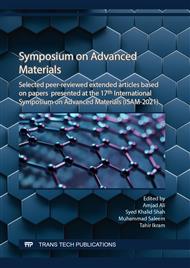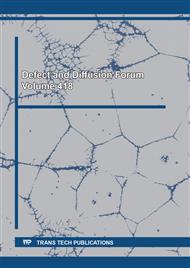[1]
Khan, R., H. H. Ya, W. Pao, M.A.A. Majid, T. Ahmed, A. Ahmad, M.A. Alam, M. Azeem, H. Iftikhar, Effect of sand fines concentration on the erosion-corrosion mechanism of carbon steel 90° elbow pipe in slug flow, Materials. 13 (2020) 4601.
DOI: 10.3390/ma13204601
Google Scholar
[2]
Zhao, X., X. Cao, Z. Xie, H. Cao, C. Wu, J. Bian, Numerical study on the particle erosion of elbows mounted in series in the gas-solid flow, Journal of Natural Gas Science and Engineering. 99 (2022) 104423.
DOI: 10.1016/j.jngse.2022.104423
Google Scholar
[3]
Li, R., Z. Sun, A. Li, Y. Li, Z. Wang, Design optimization of hemispherical protrusion for mitigating elbow erosion via cfd-dpm, Powder Technology. 398 (2022) 117128.
DOI: 10.1016/j.powtec.2022.117128
Google Scholar
[4]
Khan, R., Numerical investigation of the influence of sand particle concentration on long radius elbow erosion for liquid-solid flow, International Journal of Engineering. 32 (2019) 1485-1490.
DOI: 10.5829/ije.2019.32.10a.18
Google Scholar
[5]
Hasanzadeh Afrouzi, H.,E. Fattahi, Dispersion and deposition of micro particles over two square obstacles in a channel via hybrid lattice boltzmann method and discrete phase model, International Journal of Engineering. 25 (2012) 257-266.
DOI: 10.5829/idosi.ije.2012.25.03c.10
Google Scholar
[6]
Parsi, M., K. Najmi, F. Najafifard, S. Hassani, B.S. McLaury, S.A. Shirazi, A comprehensive review of solid particle erosion modeling for oil and gas wells and pipelines applications, Journal of Natural Gas Science and Engineering. 21 (2014) 850-873.
DOI: 10.1016/j.jngse.2014.10.001
Google Scholar
[7]
Xiao, F., M. Luo, S. Kuang, M. Zhou, J. Jing, J. Li, R. Lin, J. An, Numerical investigation of elbow erosion in the conveying of dry and wet particles, Powder Technology. 393 (2021) 265-279.
DOI: 10.1016/j.powtec.2021.07.080
Google Scholar
[8]
Zhang, J., B.S. McLaury, S.A. Shirazi, Modeling sand fines erosion in elbows mounted in series, Wear. 402-403 (2018) 196-206.
DOI: 10.1016/j.wear.2018.02.009
Google Scholar
[9]
Wang, K., X. Li, Y. Wang, R. He, Numerical investigation of the erosion behavior in elbows of petroleum pipelines, Powder Technology. 314 (2017) 490-499.
DOI: 10.1016/j.powtec.2016.12.083
Google Scholar
[10]
Mazumder, Q.H., Effect of liquid and gas velocities on magnitude and location of maximum erosion in u-bend, (2012).
Google Scholar
[11]
Khan, R., H. H. Ya, W. Pao, M.Z. bin Abdullah, F.A. Dzubir, Influence of sand fines transport velocity on erosion-corrosion phenomena of carbon steel 90-degree elbow, Metals. 10 (2020) 626.
DOI: 10.3390/met10050626
Google Scholar
[12]
Chen, J., Y. Wang, X. Li, R. He, S. Han, Y. Chen, Erosion prediction of liquid-particle two-phase flow in pipeline elbows via cfd–dem coupling method, Powder Technology. 275 (2015) 182-187.
DOI: 10.1016/j.powtec.2014.12.057
Google Scholar
[13]
Keshavarz moraveji, m.,K. Azizi, Computational fluid dynamic- two fluid model study of gas-solid heat transfer in a riser with various inclination angles, International Journal of Engineering. 30 (2017) 464-472.
DOI: 10.5829/idosi.ije.2017.30.04a.02
Google Scholar
[14]
Naz, M.Y., S. Shukrullah, M. Noman, M. Yaseen, M. Naeem, S.A. Sulaiman, Effect of water-mixed polyvinyl alcohol viscosity on wear response of carbon steel exposed to an eroding medium, Journal of Materials Engineering and Performance. 30 (2021) 2066-2073.
DOI: 10.1007/s11665-021-05483-z
Google Scholar
[15]
Oka, Y.I.,T. Yoshida, Practical estimation of erosion damage caused by solid particle impact: Part 2: Mechanical properties of materials directly associated with erosion damage, Wear. 259 (2005) 102-109.
DOI: 10.1016/j.wear.2005.01.040
Google Scholar
[16]
Pereira, G.C., F.J. de Souza, D.A. de Moro Martins, Numerical prediction of the erosion due to particles in elbows, Powder Technology. 261 (2014) 105-117.
DOI: 10.1016/j.powtec.2014.04.033
Google Scholar
[17]
Zeng, L., G.A. Zhang, X.P. Guo, Erosion–corrosion at different locations of x65 carbon steel elbow, Corrosion Science. 85 (2014) 318-330.
DOI: 10.1016/j.corsci.2014.04.045
Google Scholar



